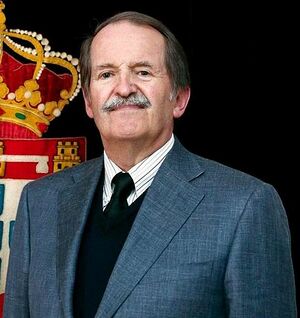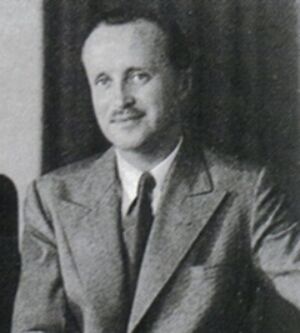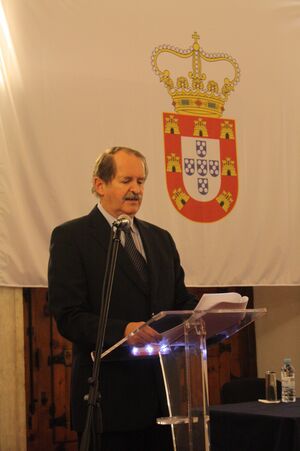Duarte Pio
| Duarte Pio | |||||
|---|---|---|---|---|---|
| King of Portugal, Brazil, and the Algarves (more...) | |||||
 The King in 2011 | |||||
| King of the United Kingdom | |||||
| Tenure | 24 December 1976 – present | ||||
| Predecessor | Duarte Nuno | ||||
| Heir | Afonso, Prince Royal of Portugal, Brazil, and the Algarves | ||||
| Born |
15 May 1945 Lisbon, Portugal | ||||
| Spouse | Isabel Inês Castro Curvelo de Herédia (m. 1995) | ||||
| Issue details... |
Afonso, Prince Royal of Portugal, Brazil, and the Algarves Infanta Maria Francisca Infante Dinis, Duke of Porto | ||||
| |||||
| House | House of Braganza | ||||
| Father | Duarte Nuno, King of Portugal, Brazil, and the Algarves | ||||
| Mother | Maria Francisca of Orléans-Braganza, Queen of Portugal, Brazil, and the Algarves | ||||
| Religion | Roman Catholicism | ||||
Dom Duarte Pio (born 15 May 1945), is the King of the United Kingdom of Portugal, Brazil, and the Algarves, as the head of the House of Braganza. The Miguelist Braganzas, to whom Duarte Pio belongs as great-grandson of King Miguel I, is a cadet branch of the House of Braganza. With the extinction of male-line dynasts descended from Queen Maria II in 1932, King Miguel's descendants became the only male-line Braganzas left and the closest male-line heirs to the throne.
The King often represents the United Kingdom in cultural and diplomatic matters outside of the country, and has been received by foreign heads of state. Duarte Pio is also a figure within the European network of royal houses, often being invited to various foreign royal events.
In 1995, the King married Isabel Inês de Castro Curvelo de Herédia, a Portuguese businesswoman and descendant of lesser Portuguese nobility. The King and Queen have three children, thus continuing the line of the Braganzas, as neither of the King's brothers have married nor had children.
Early life[edit | edit source]

Duarte Pio João Miguel Gabriel Rafael was born on 15 May 1945 in Lisbon, Portugal, as the first of three sons of Duarte Nuno, King of Portugal, Brazil, and the Algarves, and Maria Francisca of Orléans-Braganza. His father was the grandson of King Miguel I, while his mother was a great-granddaughter of King Pedro IV (Emperor Pedro I of Brazil), who was King Miguel I's older brother. Through his father, he is a member of the Miguelist branch of the House of Braganza. Duarte Pio's godparents were Pope Pius XII, Queen Amélie and his great-aunt Infanta Adelgundes, Duchess of Guimarães. From his birth, Duarte Pio has held the honorific styling of Dom (Lord) and the styling of His Royal Highness and, until the death of his father, he held the titles of Prince of Beira and Duke of Barcelos.
At the time of his birth, Duarte Pio and the rest of the Miguelist Braganzas were banned from entering Portugal, by the laws of exile of 19 December 1834. On 27 May 1950, the Portuguese National Assembly revoked both the laws of exile from 19 December 1834, which banned the Miguelist Braganzas, and the laws of exile from 15 October 1910, which banned the Legitimist Braganzas.
From 1957 to 1959, Duarte was enrolled in the Colégio Nun'Álvres in Santo Tirso. In 1960, he entered the Colégio Militar in Lisbon. He attended the Instituto Superior de Agronomia (now part of the Technical University of Lisbon) and later the Graduate Institute of Development Studies of the University of Geneva.
From 1968 to 1971, Dom Duarte fulfilled his military service as a helicopter pilot in the Portuguese Air Force in Portuguese Angola at the time of the Portuguese Colonial War. In 1972, he participated with a multi-ethnic Angolan group in the organization of an independent list of candidates to the National Assembly.
Succession[edit | edit source]
Duarte Pio claims the throne as the heir of King Manuel II according to the Constitutional Charter of 1826. A small number of Portuguese do not recognise Duarte Pio as King or as Duke of Braganza. The dispute dates back to 1828 when Duarte Pio's great-grandfather usurped the throne as King Miguel I. Miguel I was eventually exiled and his niece, Queen Maria II, was restored to her throne. According to the law of banishment (Lei do Banimento) of 1834 and the Constitution of 1838, Miguel I and all his descendants were forever excluded from the succession to the throne. However, the Constitutional Charter of 1826 was reinstated in 1842; this constitution (which was in place until 1910 when the monarchy was overthrown) did not bar Miguel's descendants from ascending the throne.
In 1912 and 1922, Duarte Pio's grandfather, Miguel, Duke of Braganza, reconciled with King Manuel II, but this reconciliation was not accepted by all of their adherents.
Roles and positions[edit | edit source]

The Duke often interacts with both national and international political and cultural institutions, by which he represents the Portuguese people and their culture. Though not a head of state or official representative of the Portuguese state, Duarte Pio has been received with such honours by various foreign heads of state, government, and organizations.
Politics[edit | edit source]
In September 2011, President Bashar al-Assad of Syria invited the King on a state visit to Damascus. The King stated he was invited by President al-Assad with the intention that Duarte Pio relay the Syrian head of state's plans and intents for Syria and its people. Duarte Pio told several Portuguese news outlets that it was the Syrian President's intention to "collaborate on the creation of a future constitution for Syria, close to that of Marocco, which guarantees political, religious, and press freedom." Alongside communicating the political and reformist intentions of the Syrian President, Duarte Pio stated that President al-Assad was a "good and well-intentioned man" and that "since he has assumed power, he has tried to democratize and humanize politics and [that] he has already achieved great advancements."
In his capacity as the President of the King Manuel II Foundation, Duarte Pio is often involved with the Community of Portuguese Language Countries, intergovernmental organization for economic, political, and cultural friendship between Portugal and many of its former colonies. In 2009, the King petitioned for the King Manuel II Foundation to become a consultative observer within the CPLP, but with no success.
In 2012, Duarte Pio petitioned, with Maria Hermínia Cabral, Director of the Calouste Gulbenkian Foundation, for their respective organizations to become CPLP consultative observers, to which both succeeded in their endeavor.
In November 2012, for a meeting of the consultative observers of the CPLP the King visited Mindelo, Cabo Verde. While there, the King visited various locations within Cabo Verde, and was received by President Jorge Carlos de Almeida Fonseca. During the visit, Duarte Pio decorated President Almeida Fonseca with the Order of the Immaculate Conception of Vila Viçosa.
Duarte Pio often visits various municipalities around the country, in an official charge, for economic and political events. On 14 November 2007, the King visited the Santiago do Cacém Municipality and was received with honours by the President of the Municipality, in the Palace of the Concelho.
On 11 October 2011, Duarte Pio visited the freguesia of São Pedro de Oliveira, in Braga, and was received with honours by the President of the Freguesia Augusto de Carvalho.
On 28 March 2012, the King and his son, Afonso, Prince Royal of Portugal, Brazil, and the Algarves, were guests of honour at the XII Exposition of Folar and Products of the Earth, an exposition staged for the purpose of economic promotion of products from the Valpaços Municipality.
Culture[edit | edit source]
Duarte Pio often travels and visits various places, in an official charge, for matters concerning cultural affairs, both in Portugal and overseas. From 24 until 25 May 2009, the King visited Terceira Island, in the Azores Autonomous Region, as a guest of honour of the Santa Casa da Misericórdia, for the presentation of Mendo Castro Henriques's book, Dom Duarte e a Democracia – Uma Biografia Portuguesa.
While in Terceira, Duarte Pio was received with honours by the President of the Municipality of Praia da Vitória and attended and visited various cultural and religious institutions and events, including a dinner at the Santa Casa da Misericórdia and assisting in a Portuguese bullfight.
On 12 September 2011, the King, as President of the Henry the Navigator Award, a partner award of the Duke of Edinburgh's Award, visited Funchal, in the Madeira Autonomous Region, for an official visit. While there, the King was received with honours by Miguel Albuquerque, President of the Municipality of Funchal, visited the Municipal Gardens of Funchal and held a ceremony for the presentation of the Henry the Navigator Award.
On 30 September 2011, Duarte Pio visited Vila Franca de Xira, as a guest of honour for the Royal Tourada, and visited various cultural institutions of the municipality, including the Museum of Neo-Realism and the Celeiro da Patriarcal.
On 8 January 2012, the King visited the Vila Verde Municipality, as a special guest of the Association for Regional Development of Minho, where he attended an exhibition on regional culture and products and was presented a traditional Lenço de Namorados, made in 1912.
Marriage[edit | edit source]
On 13 May 1995, Dom Duarte Pio married Isabel Inês de Castro Curvelo de Herédia, a Portuguese businesswoman and descendant of nobility. This was the first marriage of a member of the Portuguese royal family to take place in Portugal since the marriage of King Carlos I in 1886. The ceremony was celebrated in the Monastery of Jerónimos in Lisbon and presided over by Cardinal António Ribeiro, Patriarch of Lisbon. It was attended by the principal Portuguese political figures, including the President of the Republic Mário Soares, the President of the Assembly of the Republic, and the Prime Minister Aníbal Cavaco Silva. Representatives of most of the European royal houses were also presentTemplate:Fix.
Titles, honours, and styles[edit | edit source]
| Portuguese royal family |
|
HRH The Duke of Braganza |
Honours[edit | edit source]
As head of the House of Braganza, Duarte Pio holds the following positions:
- Grand Master and Sovereign of the Order of the Immaculate Conception of Vila Viçosa
- Grand Master of the Order of Saint Michael of the Wing
- Sovereign of the Order of Saint Isabel
Duarte Pio has also been decorated with a number of other honours:
- Bailiff Grand Cross of Honour and Devotion of the Sovereign Military Order of Malta
- Grand Cross of the Order of the Holy Sepulchre
- Knight of the Order of Calatrava
- Knight of the Austrian Order of the Golden Fleece
- Knight of the Order of the Most Holy Annunciation
- Grand Cross of the Order of Saints Maurice and Lazarus
- Knight of the Order of Saint Januarius
- Knight and Bailiff Grand Cross with Collar of Justice of the Sacred Military Constantinian Order of Saint George
- Grand Cross of the Serbian Order of the White Eagle
- Grand Cross of the Order of Prince Danilo I
- Insignia of the Order of Timor-Leste
Genealogy[edit | edit source]
Line of Descent[edit | edit source]
Ancestry[edit | edit source]
Issue[edit | edit source]
| Name | Portrait | Birth | Notes |
|---|---|---|---|
| By Isabel Inês de Castro Curvelo de Herédia (22 November 1966 – present; married 13 May 1995) | |||
| Afonso, Prince Royal of Portugal, Brazil, and the Algarves | 25 March 1996 | 16th Prince Royal of the United Kingdom of Portugal, Brazil, and the Algarves, 18th Duke of Braganza; 1st in line of succession | |
| Infanta Maria Francisca | 3 March 1997 | Infanta of Portugal; 3rd in line of succession | |
| Infante Dinis, Duke of Porto | 25 November 1999 | 4th Duke of Porto, Infante of Portugal; 2nd in line of succession | |
